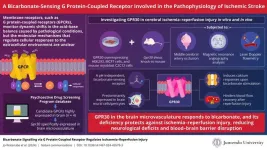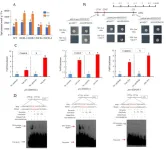(Press-News.org) Research Highlights
Closer proximity to and a higher number of ready-to-eat food outlets — particularly pubs, bars and fast-food restaurants — may be associated with a greater risk of developing heart failure, according to a study of half a million adults in the UK Biobank.
The association between food environments and increased heart failure risk was stronger among people who did not have a college degree and those living in urban areas without access to facilities for physical activity such as gyms or fitness centers.
Embargoed until 4 a.m. CT/5 a.m. ET Tuesday, Feb. 27, 2024
DALLAS, Feb. 27, 2024 — Living close to pubs, bars and fast-food restaurats may lead to a higher risk of heart failure, according to new research published today in Circulation: Heart Failure, an American Heart Association journal.
These kinds of ready-to-eat food environments typically provide unhealthy foods and drinks, and have been linked to cardiovascular diseases, said study senior author Lu Qi, M.D., Ph.D., a professor in the epidemiology department at Tulane University in New Orleans.
Heart failure is a condition in which the heart muscle can’t pump enough blood to meet the body’s needs for blood and oxygen. Few studies have assessed the relationship between heart failure and food environment, the authors noted. This study is likely the first to assess the association between food environment and heart failure with long-term observation.
“Most previous research on the relation between nutrition and human health has been focused on food quality, while neglecting the impact of food environment,” Qi said. “Our study highlights the importance of accounting for food environment in nutrition research.”
Researchers evaluated the association using data from the UK Biobank — a large-scale database containing health information for more than 500,000 adults in the United Kingdom. They measured enrollees’ exposure to three types of food environments — pubs or bars, restaurants or cafeterias and fast-food restaurants. Exposure was determined by proximity (living within 1-kilometer/0.62 miles – or a within a 15-minute walk) and density (the number of ready-to-eat food outlets within the predefined 1-kilometer/0.62 miles).
The study documented nearly 13,000 heart failure cases during a 12-year follow-up period, recorded through national electronic health-related datasets.
The analysis found that a closer proximity and a greater density of ready-to-eat food outlets were associated with an elevated risk of heart failure.
Specifically, the results include:
Overall, participants in the highest density of ready-to-eat food outlets — defined as 1 kilometer/.62 mile area with 11 or more ready-to-eat outlets — had a 16% greater risk of heart failure compared to those with no ready-to-eat food environments near their homes.
Those in the highest density areas of pubs and bars showed a 14% higher risk for heart failure; while those in the highest density areas for fast-food outlets had a 12% higher risk.
Participants who lived closest to pubs and bars — less than 500 meters (.31 miles) — had a 13% higher risk of heart failure; while those closest to fast-food outlets had a 10% higher risk compared to those who lived the farthest away (more than 2,000 meters or 1.24 miles.
Heart failure risk was stronger among participants without a college degree and adults in urban areas without access to formal physical activity facilities such as gyms.
The findings were in line with expectations, Qi said, “because previous studies have suggested that exposure to ready-to-eat food environments is associated with risks of other disorders, such as Type 2 diabetes and obesity, which may also increase the risk of heart failure.”
Authors noted the findings suggest that improving access to healthier food environments and physical fitness facilities in urban areas, along with helping more people attain higher levels of education, could reduce the increased risk of heart failure linked to quick-meal options.
An accompanying editorial by Elissa Driggin M.D., M.S., and Ersilia M. DeFilippis, M.D., both of Columbia University Medical Center in New York, notes that more detailed analyses are needed in communities with more racially and ethnically diverse populations.
“Given the clear association between Black race and high incidence of heart failure as compared to white patients, as well as associations with worse heart failure outcomes, attention to food environment in this high-risk population is of the utmost importance,” they wrote.
“It has already been demonstrated that compared to predominantly white neighborhoods, there are significantly fewer supermarkets in predominantly Black neighborhoods, which are likely to be inversely associated with ready-to-eat food environments.”
The American Heart Association is working to improve access to healthy food among patients receiving treatment for chronic health conditions and people at high risk for such conditions. The Association’s Health Care by Food TM initiative is investing in research, advocacy and education to show clinical benefit and cost effectiveness of interventions that use food as medicine so that such interventions are covered by public and private health insurance.
A 2023 Association Presidential Advisory reviewing the landscape for food is medicine practice and research noted that one of the major challenges to eating healthier is the lack of a systemic focus on improving food environments and the food system. With few exceptions, taxes and financial incentives are not directed toward encouraging the purchase of healthy foods, improving the healthfulness of local food environments or ensuring the health of children and future generations, according to the advisory.
“Consuming a healthy diet is too hard for too many people,” said Eduardo Sanchez, M.D., M.P.H., FAHA, the Association’s chief medical officer for prevention. “Structural racism and factors that contribute to poverty mean that historically excluded people suffer the consequences of poor-quality diets at disproportionate levels. For over a century, we’ve saved and improved lives at the American Heart Association and will continue to focus on initiatives like this in our next 100 years by ensuring everyone, everywhere enjoys their healthiest lives.”
Study background and details:
Data came from UK Biobank entries for more than 500,000 adults, ages 37-73 years old recruited from 22 assessment centers in England, Scotland and Wales between March 2006 and October 2010, followed through May 2021.
Heart Failure was based on self-reported information and hospital inpatient records.
Participants, on average, were 56 years old, more than half were women and 94% were of white European ancestry. Participants had completed extensive questionnaires detailing personal information, such as age, sex, race, education, lifestyle habits and medical history.
Within the 1-kilometer range of where participants lived, there were 3.57 ready-to-eat food outlets on average.
The average street distance to pubs and bars was 692 meters (0.43 miles); 820 meters (0.50 miles) to restaurants and cafeterias; and 1,135 meters (0.70 miles) to fast-food restaurants. Participants included in the analysis were exposed to the highest density category of composite ready-to-eat food environments.
Although the research used a large sample size, it may not represent the general population because most participants were white, skewed older and lived in the U.K. Other limitations include potential for exposure misclassification because of participants’ movements among neighborhoods during the follow-up period. The study did not rule out other factors that may involve a particular food environment that could affect heart failure and did not include nutrition insecurity data. In addition, it cannot show causality because the research is observational based on previously collected data.
The study emphasizes the importance of improving food environments to prevent heart failure, and the researchers noted that more studies are needed, particularly assessing nutrition insecurity, to enhance the robustness and applicability of this study’s conclusions.
Co-authors, disclosures and funding sources are listed in the manuscript.
Statements and conclusions of studies published in the American Heart Association’s scientific journals are solely those of the study authors and do not necessarily reflect the Association’s policy or position. The Association makes no representation or guarantee as to their accuracy or reliability. The Association receives funding primarily from individuals; foundations and corporations (including pharmaceutical, device manufacturers and other companies) also make donations and fund specific Association programs and events. The Association has strict policies to prevent these relationships from influencing the science content. Revenues from pharmaceutical and biotech companies, device manufacturers and health insurance providers and the Association’s overall financial information are available here.
Additional Resources:
Available multimedia is on right column of release link https://newsroom.heart.org/news/living-near-pubs-bars-and-fast-food-restaurants-could-be-bad-for-heart-health?preview=b3dc39bad0faacbf2f9fe03d475a202a
After Feb. 27, view the manuscript and editorial online.
AHA news release: Living near a “food swamp” may increase stroke risk among adults 50 and older (Feb. 2023)
AHA news release: Lack of access to healthy food may raise risk of death from heart failure (Oct. 2022)
Follow AHA/ASA news on Twitter @HeartNews
Follow news from the AHA’s Circulation: Heart Failure journal @CircHF
###
About the American Heart Association
The American Heart Association is a relentless force for a world of longer, healthier lives. We are dedicated to ensuring equitable health in all communities. Through collaboration with numerous organizations, and powered by millions of volunteers, we fund innovative research, advocate for the public’s health and share lifesaving resources. The Dallas-based organization has been a leading source of health information for a century. During 2024 - our Centennial year - we celebrate our rich 100-year history and accomplishments. As we forge ahead into our second century of bold discovery and impact, our vision is to advance health and hope for everyone, everywhere. Connect with us on heart.org, Facebook, X (formerly known as Twitter) or by calling 1-800-AHA-USA1.
END
Living near pubs, bars and fast-food restaurants could be bad for heart health
Exposure to more ready-to-eat food outlets linked to a higher risk of heart failure, in a new study in the Circulation: Heart Failure journal
2024-02-27
ELSE PRESS RELEASES FROM THIS DATE:
Research adds to knowledge about heart disease and stroke in women of all ages
2024-02-27
Research Highlights:
Women’s heart disease and stroke risks and outcomes differ throughout life in comparison to men.
A special Journal of the American Heart Association “spotlight” issue features a collection of the latest research about sex differences in cardiovascular disease and their implications for gender-specific care.
Among the topics in this issue: the impact of sedentary behavior on heart disease risk in older women; sex differences in the relationship between schizophrenia and the development ...
Innovative therapies for ischemic stroke: Novel bicarbonate-sensing G protein-coupled receptor shows promise
2024-02-27
Cells actively rely on maintaining an appropriate acid-base balance to support optimal function. Under normal physiological settings, the pH inside cells remains within a controlled range. However, disruptions in this equilibrium have been linked to a wide range of health conditions, both minor and catastrophic. Changes in the extracellular environment are monitored by “membrane receptors,” of which the G protein-coupled receptors (GPCRs) are a large family of membrane proteins that mediate multiple cellular responses. However, the role of GPR30, also known as G protein-coupled estrogen ...
AI-driven lab speeds catalysis research
2024-02-27
Researchers have developed a “self-driving” lab that uses artificial intelligence (AI) and automated systems to provide in-depth analyses of catalytic reactions used in chemical research and manufacturing. The new tool, called Fast-Cat, can provide more information in five days than is possible in six months of conventional testing.
At issue are the yield and selectivity of chemical reactions in the presence of molecules called ligands.
Yield refers to how efficiently a chemical reaction produces a desired product from the chemicals you started with. Selectivity refers ...
Unveiling the sustainability landscape in cultural organizations: A global benchmark
2024-02-27
Are museums, theaters, and opera houses truly walking the talk when it comes to social and environmental sustainability? The University of Lausanne (UNIL) delved into this pressing question, conducting an international survey with over 200 major cultural organizations. The verdict? While there's significant room for improvement across the spectrum, Anglophone countries lead the charge.
Cultural organizations, with their wide-reaching influence and power to shape narratives and imaginations, are poised to ...
The mechanism of SlWRKY80 participating in salt alkali stress through its involvement in JA metabolic pathway
2024-02-27
Tomato (Solanum lycopersicum L.) is the most widely cultivated and consumed horticultural crop. At present, saline–alkali is an important abiotic stress source that affects tomato production. Exogenous methyl jasmonate (MeJA) can enhance the resistance of tomatoes to various stress, but its exact mechanism is still unclear.
In January 2024, Horticulture Research published a research entitled by “SlWRKY80-mediated jasmonic acid pathway positively regulates tomato resistance to saline-alkali stress by enhancing spermidine content and stabilizing ...
Abdominal fat can impact brain health and cognition in high Alzheimer’s risk individuals
2024-02-27
The impact of abdominal fat on brain health and cognition is generally more pronounced in middle-aged men at high risk of Alzheimer’s disease as opposed to women, according to researchers at Rutgers Health.
In middle-aged individuals with a family history of Alzheimer’s disease, the amount of fat in their abdominal organs (pancreas, liver, and belly fat) is related to their brain volumes and cognitive function, according to the study published in the journal Obesity. The study was written by Sapir Golan Shekhtman, a Ph.D. student at the Joseph Sagol Neuroscience Center at the Sheba Medical Center in Israel and led by ...
New data analysis supports hedonic overdrive model in high-fat diet-induced mice
2024-02-27
ROCKVILLE, Md.— High-fat diets cause obesity in male mice. The underlying mechanism, however, remains controversial. After assessing three contrasting ideas, researchers have determined that the hedonic overdrive model provides the best fit, according to a new study published in the journal Obesity, The Obesity Society’s (TOS) flagship journal.
“Our work provides some direction as to why high-fat/high-carb macronutrient combinations stimulate overconsumption. The study is in mice so we ...
Pythagoras was wrong: there are no universal musical harmonies, new study finds
2024-02-27
The tone and tuning of musical instruments has the power to manipulate our appreciation of harmony, new research shows. The findings challenge centuries of Western music theory and encourage greater experimentation with instruments from different cultures.
According to the Ancient Greek philosopher Pythagoras, ‘consonance’ – a pleasant-sounding combination of notes – is produced by special relationships between simple numbers such as 3 and 4. More recently, scholars have tried to find psychological explanations, but these ‘integer ratios’ are still credited with making a chord sound beautiful, and deviation from them ...
Researchers uncover new clues about links between parent age and congenital disorders
2024-02-27
A new paper in Genome Biology and Evolution, published by Oxford University Press, finds that the link between paternal age and rare congenital disorders is more complex than scientists had previously thought. While researchers have long realized that older fathers are more likely to have children with bone and heart malformations, such as Achondroplasia, Apert, or Noonan syndrome or neurodevelopmental disorders, schizophrenia, and autism, new examination indicates that while the link between some pathogenic mutations increases with paternal age, others do not and may even occur in the father’s testis before sexual maturity.
Delayed fatherhood results in a higher ...
Study reveals parental smoking and childhood obesity link transcends socio-economic boundaries
2024-02-27
A study into parental smoking and childhood obesity has challenged previous notions by revealing that the links between the two are not confined to a specific socio-economic group.
The data shows a strong correlation between parents who smoke and their children’s consumption of high calorie unhealthy foods and drinks, across social classes.
Using longitudinal data on 5,000 Australian children collected over a 10-year period, the research found those living with parents who smoke, on average, eat less healthy, higher calorie food such as fruit juice, sausages, fries, snacks, full fat milk products, ...
LAST 30 PRESS RELEASES:
Tracing the quick synthesis of an industrially important catalyst
New software sheds light on cancer’s hidden genetic networks
UT Health San Antonio awarded $3 million in CPRIT grants to bolster cancer research and prevention efforts in South Texas
Third symposium spotlights global challenge of new contaminants in China’s fight against pollution
From straw to soil harmony: International team reveals how biochar supercharges carbon-smart farming
Myeloma: How AI is redrawing the map of cancer care
Manhattan E. Charurat, Ph.D., MHS invested as the Homer and Martha Gudelsky Distinguished Professor in Medicine at the University of Maryland School of Medicine
Insilico Medicine’s Pharma.AI Q4 Winter Launch Recap: Revolutionizing drug discovery with cutting-edge AI innovations, accelerating the path to pharmaceutical superintelligence
Nanoplastics have diet-dependent impacts on digestive system health
Brain neuron death occurs throughout life and increases with age, a natural human protein drug may halt neuron death in Alzheimer’s disease
SPIE and CLP announce the recipients of the 2025 Advanced Photonics Young Innovator Award
Lessons from the Caldor Fire’s Christmas Valley ‘Miracle’
Ant societies rose by trading individual protection for collective power
Research reveals how ancient viral DNA shapes early embryonic development
A molecular gatekeeper that controls protein synthesis
New ‘cloaking device’ concept to shield sensitive tech from magnetic fields
Researchers show impact of mountain building and climate change on alpine biodiversity
Study models the transition from Neanderthals to modern humans in Europe
University of Phoenix College of Doctoral Studies releases white paper on AI-driven skilling to reduce burnout and restore worker autonomy
AIs fail at the game of visual “telephone”
The levers for a sustainable food system
Potential changes in US homelessness by ending federal support for housing first programs
Vulnerability of large language models to prompt injection when providing medical advice
Researchers develop new system for high-energy-density, long-life, multi-electron transfer bromine-based flow batteries
Ending federal support for housing first programs could increase U.S. homelessness by 5% in one year, new JAMA study finds
New research uncovers molecular ‘safety switch’ shielding cancers from immune attack
Bacteria resisting viral infection can still sink carbon to ocean floor
Younger biological age may increase depression risk in older women during COVID-19
Bharat Innovates 2026 National Basecamp Showcases India’s Most Promising Deep-Tech Ventures
Here’s what determines whether your income level rises or falls
[Press-News.org] Living near pubs, bars and fast-food restaurants could be bad for heart healthExposure to more ready-to-eat food outlets linked to a higher risk of heart failure, in a new study in the Circulation: Heart Failure journal




